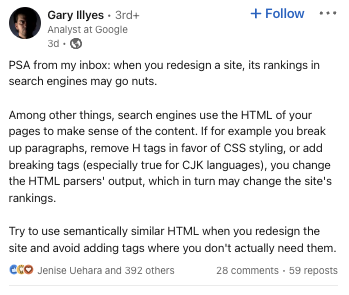SEO
Google’s Gary Illyes Answers Your SEO Questions On LinkedIn

Google Analyst Gary Illyes offers guidance on large robots.txt files, the SEO impact of website redesigns, and the correct use of rel-canonical tags.
Illyes is taking questions sent to him via LinkedIn direct message and answering them publicly, offering valuable insights for those in the SEO community.
It’s already newsworthy for a Google employee to share SEO advice. This is especially so given it’s Illyes, who isn’t as active on social media as colleagues like Search Advocate John Mueller and Developer Advocate Martin Splitt.
Throughout the past week, Illyes has shared advice and offered guidance on the following subjects:
- Large robots.txt files
- The SEO impact of website redesigns
- The correct use of rel-canonical tags
Considering the engagement his posts are getting, there’s likely more to come. Here’s a summary of what you missed if you’re not following him on LinkedIn.
Keep Robots.Txt Files Under 500KB
Regarding a previously published poll on the size of robots.txt files, Illyes shares a PSA for those with a file size larger than 500kb.
Illyes advises paying attention to the size of your website’s robots.txt file, especially if it’s larger than 500kb.
Google’s crawlers only process the first 500kb of the file, so it’s crucial to ensure that the most important information appears first.
Doing this can help ensure that your website is properly crawled and indexed by Google.
Website Redesigns May Cause Rankings To Go “Nuts”
When you redesign a website, it’s important to remember that its rankings in search engines may be affected.
As Illyes explains, this is because search engines use the HTML of your pages to understand and categorize the content on your site.
If you make changes to the HTML structure, such as breaking up paragraphs, using CSS styling instead of H tags, or adding unnecessary breaking tags, it can cause the HTML parsers to produce different results.
This can significantly impact your site’s rankings in search engines. Or, as Illyes phrases it, it can cause rankings to go “nuts”:
 Screenshot from: linkedin.com/in/garyillyes/, January 2023.
Screenshot from: linkedin.com/in/garyillyes/, January 2023.Illyes advises using semantically similar HTML when redesigning the site and avoiding adding tags that aren’t necessary to minimize the SEO impact.
This will allow HTML parsers to better understand the content on your site, which can help maintain search rankings.
Don’t Use Relative Paths In Your Rel-Canonical
Don’t take shortcuts when implementing rel-canonical tags. Illyes strongly advises spelling out the entire URL path:
 Screenshot from: linkedin.com/in/garyillyes/, January 2023.
Screenshot from: linkedin.com/in/garyillyes/, January 2023.Saving a few bytes using a relative path in the rel-canonical tag isn’t worth the potential issues it could cause.
Using relative paths may result in search engines treating it as a different URL, which can confuse search engines.
Spelling out the full URL path eliminates potential ambiguity and ensures that search engines identify the correct URL as the preferred version.
In Summary
By answering questions sent to him via direct message and offering his expertise, Illyes is giving back to the community and providing valuable insights on various SEO-related topics.
This is a testament to Illyes’ dedication to helping people understand how Google works. Send him a DM, and your question may be answered in a future LinkedIn post.
Source: LinkedIn
Featured Image: SNEHIT PHOTO/Shutterstock



















You must be logged in to post a comment Login